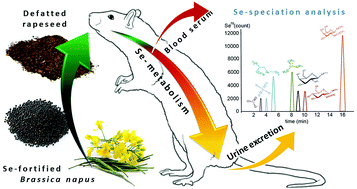当前位置:
X-MOL 学术
›
Metallomics
›
论文详情
Our official English website, www.x-mol.net, welcomes your
feedback! (Note: you will need to create a separate account there.)
Metabolic transformation and urinary excretion of selenium (Se) in rats fed a Se-enriched defatted rapeseed (Brassica napus, L.) diet†
Metallomics ( IF 2.9 ) Pub Date : 2018-02-21 00:00:00 , DOI: 10.1039/c7mt00325k Zuzana Čadková 1, 2, 3, 4, 5 , Jiřina Száková 2, 3, 4, 5, 6 , Jana Tremlová 2, 3, 4, 5, 6 , Oldřich Kopecký 1, 2, 3, 4, 5 , Ondřej Žíla 1, 2, 3, 4, 5 , Pavel Tlustoš 2, 3, 4, 5, 6
Metallomics ( IF 2.9 ) Pub Date : 2018-02-21 00:00:00 , DOI: 10.1039/c7mt00325k Zuzana Čadková 1, 2, 3, 4, 5 , Jiřina Száková 2, 3, 4, 5, 6 , Jana Tremlová 2, 3, 4, 5, 6 , Oldřich Kopecký 1, 2, 3, 4, 5 , Ondřej Žíla 1, 2, 3, 4, 5 , Pavel Tlustoš 2, 3, 4, 5, 6
Affiliation

|
Se-Enriched defatted rapeseed (Se-DRS), a by-product of rapeseed oil production, is high in Se. This study aimed to detect possible changes in Se-metabolism after Se-DRS consumption and to assess its suitability as a Se supplement in monogaster feed. In this experiment, rats were fed three types of diets differing in Se-form: soybean meal, Se-salt and Se-DRS. Potential differences in Se-metabolism were evaluated based on the total Se concentrations along with non-protein Se speciation patterns in the urine and blood serum of the rats. The total Se concentrations were determined using inductively coupled plasma-mass spectrometry (ICP-MS). Se compounds in the samples were identified through high-performance liquid chromatography/ICP-MS. The total Se excretion rate was dose-dependent, and excess of dietary Se was eliminated in the form of Se-sugar 1, regardless of the administered Se-form. The excretion dynamics of dietary selenomethionine (soybean meal) and methylselenocysteine (Se-DRS) were different to that of the mineral Se (Se-salt). The proportions of Se species in the urine were significantly influenced by the Se source. A specific metabolic pathway, resulting in urinary excretion of Se-sugar 2, was observed in animals fed Se-DRS. Neither the total Se concentrations nor the serum Se speciation patterns differed between the animals fed the conventional diet and those fed the Se-DRS-enriched diet. Based on these results, Se-DRS can be considered a suitable Se supplement for monogaster nutrition in Se-deficient regions.
中文翻译:

饲喂富含硒的脱脂菜籽(甘蓝型油菜)饮食的大鼠中硒的硒的代谢转化和尿排泄†
富硒的脱脂菜籽(Se-DRS)是菜籽油生产的副产品,含硒量很高。这项研究旨在检测食用Se-DRS后Se代谢的可能变化,并评估其在Monogaster饲料中作为Se补充剂的适用性。在该实验中,给大鼠喂食了三种硒形式不同的饮食:豆粕,硒盐和硒-DRS。根据总硒浓度以及大鼠尿液和血清中的非蛋白质硒形态模式,评估硒代谢的潜在差异。使用电感耦合等离子体质谱法(ICP-MS)确定总Se浓度。样品中的硒化合物通过高效液相色谱/ ICP-MS鉴定。硒的总排泄率是剂量依赖性的,以硒糖1的形式消除了饮食中过量的硒。不论施用的Se形式如何。日粮硒代蛋氨酸(大豆粉)和甲基硒代半胱氨酸(Se-DRS)的排泄动态与矿物质硒(Se-盐)的排泄动态不同。尿中硒种类的比例受硒源的影响很大。在饲喂Se-DRS的动物中观察到一种特定的代谢途径,导致尿糖2排泄。在饲喂常规饮食的动物和饲喂富含Se-DRS的饮食的动物之间,总硒浓度和血清硒形态均无差异。根据这些结果,可以将Se-DRS视为缺硒地区Monogaster营养的合适Se补充剂。日粮硒代蛋氨酸(大豆粉)和甲基硒代半胱氨酸(Se-DRS)的排泄动态与矿物质硒(Se-盐)的排泄动态不同。尿中硒种类的比例受硒源的影响很大。在饲喂Se-DRS的动物中观察到一种特定的代谢途径,导致尿糖2排泄。在饲喂常规饮食的动物和饲喂富含Se-DRS的饮食的动物之间,总硒浓度和血清硒形态均无差异。根据这些结果,可以将Se-DRS视为缺硒地区Monogaster营养的合适Se补充剂。日粮硒代蛋氨酸(大豆粉)和甲基硒代半胱氨酸(Se-DRS)的排泄动态与矿物质硒(Se-盐)的排泄动态不同。尿中硒种类的比例受硒源的影响很大。在饲喂Se-DRS的动物中观察到一种特定的代谢途径,导致尿中糖2的排泄。在饲喂常规饮食的动物和饲喂富含Se-DRS的饮食的动物之间,总硒浓度和血清硒形态均无差异。根据这些结果,可以将Se-DRS视为缺硒地区Monogaster营养的合适Se补充剂。在饲喂Se-DRS的动物中观察到了这种现象。在饲喂常规饮食的动物和饲喂富含Se-DRS的饮食的动物之间,总硒浓度和血清硒形态均无差异。根据这些结果,可以将Se-DRS视为缺硒地区Monogaster营养的合适Se补充剂。在饲喂Se-DRS的动物中观察到了这种现象。在饲喂常规饮食的动物和饲喂富含Se-DRS的饮食的动物之间,总硒浓度和血清硒形态均无差异。根据这些结果,可以将Se-DRS视为缺硒地区Monogaster营养的合适Se补充剂。
更新日期:2018-02-21
中文翻译:

饲喂富含硒的脱脂菜籽(甘蓝型油菜)饮食的大鼠中硒的硒的代谢转化和尿排泄†
富硒的脱脂菜籽(Se-DRS)是菜籽油生产的副产品,含硒量很高。这项研究旨在检测食用Se-DRS后Se代谢的可能变化,并评估其在Monogaster饲料中作为Se补充剂的适用性。在该实验中,给大鼠喂食了三种硒形式不同的饮食:豆粕,硒盐和硒-DRS。根据总硒浓度以及大鼠尿液和血清中的非蛋白质硒形态模式,评估硒代谢的潜在差异。使用电感耦合等离子体质谱法(ICP-MS)确定总Se浓度。样品中的硒化合物通过高效液相色谱/ ICP-MS鉴定。硒的总排泄率是剂量依赖性的,以硒糖1的形式消除了饮食中过量的硒。不论施用的Se形式如何。日粮硒代蛋氨酸(大豆粉)和甲基硒代半胱氨酸(Se-DRS)的排泄动态与矿物质硒(Se-盐)的排泄动态不同。尿中硒种类的比例受硒源的影响很大。在饲喂Se-DRS的动物中观察到一种特定的代谢途径,导致尿糖2排泄。在饲喂常规饮食的动物和饲喂富含Se-DRS的饮食的动物之间,总硒浓度和血清硒形态均无差异。根据这些结果,可以将Se-DRS视为缺硒地区Monogaster营养的合适Se补充剂。日粮硒代蛋氨酸(大豆粉)和甲基硒代半胱氨酸(Se-DRS)的排泄动态与矿物质硒(Se-盐)的排泄动态不同。尿中硒种类的比例受硒源的影响很大。在饲喂Se-DRS的动物中观察到一种特定的代谢途径,导致尿糖2排泄。在饲喂常规饮食的动物和饲喂富含Se-DRS的饮食的动物之间,总硒浓度和血清硒形态均无差异。根据这些结果,可以将Se-DRS视为缺硒地区Monogaster营养的合适Se补充剂。日粮硒代蛋氨酸(大豆粉)和甲基硒代半胱氨酸(Se-DRS)的排泄动态与矿物质硒(Se-盐)的排泄动态不同。尿中硒种类的比例受硒源的影响很大。在饲喂Se-DRS的动物中观察到一种特定的代谢途径,导致尿中糖2的排泄。在饲喂常规饮食的动物和饲喂富含Se-DRS的饮食的动物之间,总硒浓度和血清硒形态均无差异。根据这些结果,可以将Se-DRS视为缺硒地区Monogaster营养的合适Se补充剂。在饲喂Se-DRS的动物中观察到了这种现象。在饲喂常规饮食的动物和饲喂富含Se-DRS的饮食的动物之间,总硒浓度和血清硒形态均无差异。根据这些结果,可以将Se-DRS视为缺硒地区Monogaster营养的合适Se补充剂。在饲喂Se-DRS的动物中观察到了这种现象。在饲喂常规饮食的动物和饲喂富含Se-DRS的饮食的动物之间,总硒浓度和血清硒形态均无差异。根据这些结果,可以将Se-DRS视为缺硒地区Monogaster营养的合适Se补充剂。











































 京公网安备 11010802027423号
京公网安备 11010802027423号